
Executive Summary
Since April 2023, Arete’s Incident Response (IR) team has responded to more than one hundred incidents attributed to the Akira ransomware group. Akira is a prolific threat and quickly established itself as one of the most active ransomware groups alongside ALPHV/BlackCat and LockBit in 2023. In 2024, Akira benefited from law enforcement actions that disrupted LockBit and ALPHV/BlackCat’s operations and has continued to be one of the most active threat actor groups.
This spotlight explores the ransomware group’s observed behavior, background information on the threat actor, and statistics from Incident Response engagements, along with a technical analysis of Akira’s ransomware executable. Finally, we discuss security recommendations to better defend against this evolving cyber threat and mitigate the risk of financial and reputational losses.
Incident Response Data on the Akira Ransomware Group
The information below is based on engagements involving Akira ransomware investigated by Arete since April 2023. Our IR, Threat Intelligence, and Data Analytics teams work together to analyze key data points during every ransomware engagement and form real-time threat actor (TA) insights.
- Targeted sectors include healthcare, hospitality, manufacturing, public and financial services, and professional services.
- The median initial demand is $500,000.
- The median ransom payment facilitated is $150,000.
- Tools observed during investigations include SystemBC, Cobalt Strike, Rclone, Filezilla, WinSCP, AnyDesk, PuTTY, SoftPerfect Network Scanner (netscan), Advanced IP Scanner, and Angry IP Scanner.
- Over the last six months, 43% of engagements involved data exfiltration.
- Depending on the variant, Akira encrypts and appends an “.akira”, “.powerranges”, or “.akiranew” extension to encrypted files.
- The ransom note file name is commonly “akira_readme.txt” or “powerranges.txt” and includes a password-protected Tor site for negotiations and communication with victims.
- The group operates a data leak site (DLS) self-proclaimed as “AKIRA” and commonly threatens victims with releasing stolen data as a pressure tactic if a payment is not made.
- Akira will delete Windows Shadow Volume Copies using Powershell and utilize Windows’ Restart Manager to exit processes and services that could potentially prevent encryption.
Background
Akira has evolved into a notable ransomware operation and was among the top variants observed by Arete in the first half of 2024.

Akira targets a broad range of organizations throughout North America, including Canada, and swiftly lists victims on its data leak site. Targeted sectors include healthcare, hospitality, manufacturing, public and financial services, and professional services. The group maintains Windows and Linux versions of its ransomware and uses virtual private network (VPN) appliances as an initial access vector in 50% of attacks.
Megazord, a variant of Akira, demonstrates the evolution of the group’s ransomware. Introduced around August 2023, this variant is unique due to its Rust-based code, which is a departure from the C++ code of the original Akira ransomware. The Megazord variant also includes different command line arguments and encrypts files with a “.powerranges” extension, which are differentiating attributes.
Technical Analysis
Malware analysis of one of the Windows-based variants revealed that Akira ransomware:
- Supports multiple command-line arguments.
- Encrypts files on the system and mounted shares.
- Adds the following extension to encrypted files (variant dependent): .akira (e.g., file.docx.akira).
- Creates a ransom note with the following filename (variant dependent): akira_readme.txt.
- References a data leak site in the ransom note that, when accessed, self-identifies the group as AKIRA.
- Kills a list of processes and services.
- Maintains a list of whitelisted files and directories to ensure it will not render the system unusable, preventing recovery when running a decryptor.
- Attempts to prevent system recovery by deleting the system’s volume shadow copies.
- Creates a log file with a name based on the date and time: Log-%d-%m-%Y-%H-%M-%S (e.g., Log-19-09-2024-09-21-20.txt).
Execution Pattern/Arguments
Akira ransomware does not need a command line argument to execute and encrypt files in the system. However, Akira supports the following command line arguments:
| Command line argument | Description |
|---|---|
| -p / –encryption_path | Specify a target directory to encrypt. If not provided, the payload will encrypt the local and mounted shared drives by default. |
| -s / –share_file | Encrypt shared volumes/directory files. |
| -n / –encryption_percent | Number that represents the percentage of the file that will be encrypted. |
| -localonly | Encrypt only local volumes. |
| -e/ –exclude | Meant to exclude directories but does not seem to be fully functional. |
Megazord variant:
| Command line argument | Description |
|---|---|
| –path | Path to encrypt. If not provided, the payload will encrypt the local and mounted shared drives by default. |
| –id | Unique token to execute the ransomware. |
| –threads | Number of threads (1-1000). |
| –h (–help) | Displays help options. |
| -log | Logging options with multiple logs supported (info, error, debug). Not displayed by default. |
Examples of how the supported arguments are used:
| Akira.exe -p=C:\Users\%USERNAME%\Desktop\MyFiles |
| Akira.exe –encryption_percent=10 |

Stop Services and Processes
Before file encryption, the ransomware terminates a pre-determined list of processes and services to encrypt as many files as possible. Akira ransomware contains a list of processes it will exclude during process termination, listed below:
Process names:
| explorer.exe, sihost.exe, spoolsv.exe, dwm.exe, LogonUI.exe, fontdrvhost.exe, cmd.exe, csrss.exe, smss.exe, SearchUI.exe, lsass.exe, conhost.exe, System, winlogon.exe, services.exe, wininit.exe, Registry, Memory Compression, System Idle Process, Secure System |
File and Directory Exclusions
The ransomware excludes system-related files and folders, ransomware-related files, and whitelisted extensions during encryption.
Excluded file extensions:
| .exe, .dll, .sys, .msi, .lnk, .akira, akira_readme.txt |
Excluded directories:
| tmp, temp, winnt, $Recycle.Bin, thumb, System Volume Information, $RECYCLE.BIN, Windows, ProgramData, Trend Micro, ProgramData, Boot |
Inhibit System Recovery
Windows operating systems contain features that can help fix corrupted system files, including shadow copies, which are backups of files created by the Volume Shadow Copy Service (VSS). By deleting shadow copies, the ransomware can prevent victims from restoring files from backups, making it more difficult for them to recover their data without paying the ransom.
The ransomware deletes volume shadow copies before file encryption by starting the following Powershell process and executing the command:
| powershell.exe -Command “Get-WmiObject Win32_Shadowcopy | Remove-WmiObject” |
Network Share Discovery
Akira ransomware can enumerate network-mounted shares by scanning the network interfaces. If any are found, it will attempt to encrypt them, as shown below.
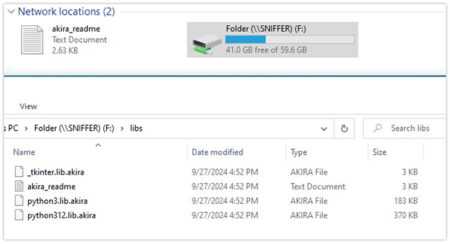
Data Encrypted for Impact
The ransomware initially finds available drives and then loads the files one by one using the Windows API FindFirstFileW and FindNextFileW. The ransomware generates random AES keys to encrypt the files, and after encrypting them, the keys are encrypted using a public RSA key. The resulting key is again encrypted and placed at the end of the file.
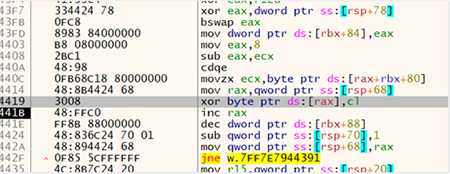

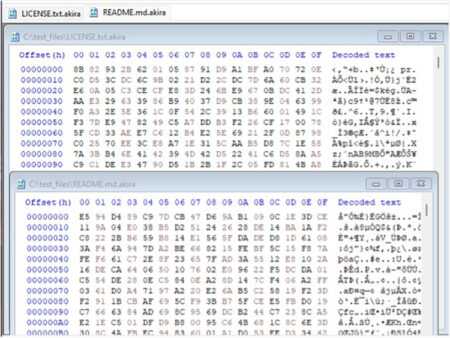
During execution, the ransomware creates a log file in the working directory where the file is executed from. The log file is named based on the date and time of execution using the following string format: Log-%d-%m-%Y-%H-%M-%S. For example, during execution, the following log file with the name was created: Log-19-09-2024-09-21-20.txt.
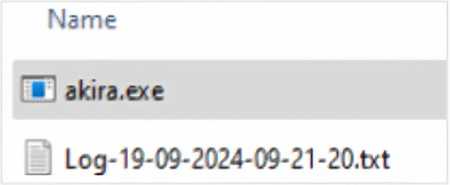
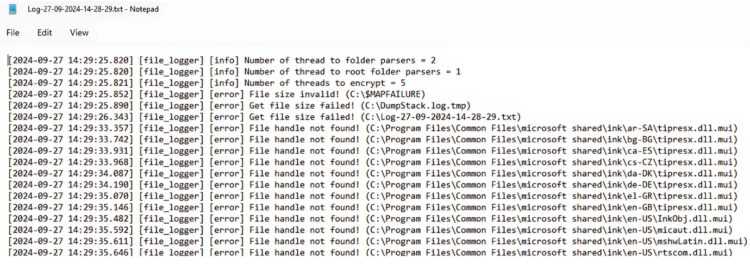

Upon successful execution, the ransomware creates ransom notes with the file name akira_readme.txt. The Megazord variant creates ransom notes with the same content, but the file name is powerranges.txt.

Ransom note content:
Hi friends,
Whatever who you are and what your title is if you’re reading this it means the internal infrastructure of your company is fully or partially dead, all your backups – virtual, physical – everything that we managed to reach – are completely removed. Moreover, we have taken a great amount of your corporate data prior to encryption.
Well, for now let’s keep all the tears and resentment to ourselves and try to build a constructive dialogue. We’re fully aware of what damage we caused by locking your internal sources. At the moment, you have to know:
- Dealing with us you will save A LOT due to we are not interested in ruining your financially. We will study in depth your finance, bank & income statements, your savings, investments etc. and present our reasonable demand to you. If you have an active cyber insurance, let us know and we will guide you how to properly use it. Also, dragging out the negotiation process will lead to failing of a deal.
- Paying us you save your TIME, MONEY, EFFORTS and be back on track within 24 hours approximately. Our decryptor works properly on any files or systems, so you will be able to check it by requesting a test decryption service from the beginning of our conversation. If you decide to recover on your own, keep in mind that you can permanently lose access to some files or accidently corrupt them – in this case we won’t be able to help.
- The security report or the exclusive first-hand information that you will receive upon reaching an agreement is of a great value, since NO full audit of your network will show you the vulnerabilities that we’ve managed to detect and used in order to get into, identify backup solutions and upload your data.
- As for your data, if we fail to agree, we will try to sell personal information/trade secrets/databases/source codes – generally speaking, everything that has a value on the darkmarket – to multiple threat actors at ones. Then all of this will be published in our blog – https://akiraI2iz6a7qgd3ayp3I6yub7xx2uep76idk3u2kolIpj5z3z636bad[.]onion
- We’re more than negotiable and will definitely find the way to settle this quickly and reach an agreement which will satisfy both of us.
If you’re indeed interested in our assistance and the services we provide you can reach out to us following simple instructions:
- Install TOR Browser to get access to our chat room – https://www.torproject.org/download/.
- Paste this link – <ONION_LINK>
- Use this code – <UNIQUE_CODE> – to log into our chat.
Keep in mind that the faster you will get in touch, the less damage we cause.
Modify Registry
The Windows registry is a database that stores configuration settings and values for the Windows operating system. It manages user preferences, installed software, system configurations, and more. Malware abuses the Windows registry to maintain persistence, hide its presence, disable security settings, and launch malicious scripts. Akira did not perform any registry key modification.
Mutex
The mutex is the fundamental tool for managing shared resources between multiple threads or processes. Typically, ransomware uses a mutex to avoid reinfecting the victim system and causing multiple layers of encryption. The ransomware did not create a mutex during execution.
Network Activity
The ransomware did not try to communicate with a remote server other than encrypting data from mounted shares.
Indicators of Compromise
| Indicator | Type | Context |
|---|---|---|
| 9f873c29a38dd265decb6517a2a1f3b5d4f90ccd42e-b61039086ea0b5e74827e | SHA256 hash | Akira ransomware |
| 2b00a02196b87445633cabde506b4387979504cf60955f0b-40cf2e4da4f0fd23 | SHA256 hash | Akira ransomware |
| 237d3c744fd5fc5d7e7a55e4385dff51045a1c6d8ee-7346a270a688ab3791d49 | SHA256 hash | Akira ransomware |
| akira_readme.txt, powerranges.txt | File name | Akiraransom notes |
| .akira, .powerranges, .akiranew | Extension | Encrypted files extension |
| powershell.exe -Command “Get-WmiObject Win32_Shadowcopy | Remove-WmiObject” | Process | Volume Shadow Copy deletion |
| Log-19-09-2024-09-21-20.txt | File name | Example log file name created by Akira |
| https://akirai2iz6a7qgd3ayp3l6yub7xx2uep76idk3u2kolIpj5z3z636bad[.]onion | URL | TA data leak site (DLS) |
Data Leak Site
The ransom note contains a data leak site (DLS) that, when accessed, displayed the following page, self-identifying the group as Akira:
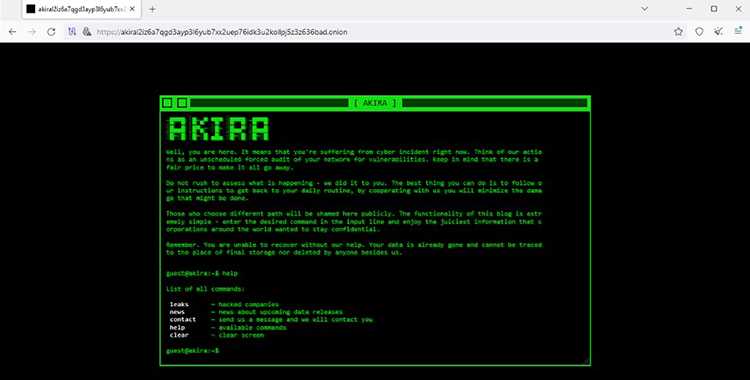
Tor Chat Site
The ransom note contains a Tor chat site and a unique code used to log into the chat. The Tor chat site displayed the following page:
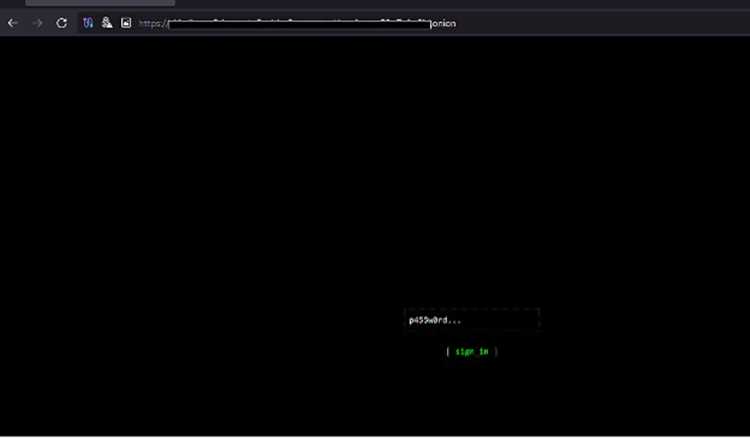
Detection Mechanisms
Custom Detections and Blocking with Arete’s Arsenal
SentinelOne S1QL 1.0 query syntax (STAR rule):
Volume Shadow Copy Deletion
EndpointOS = "windows" AND ObjectType = "process" AND TgtProcCmdLine Contains Anycase "powershell.exe" AND TgtProcCmdLine Contains Anycase "-Command" AND TgtProcCmdLine Contains Anycase "Get-WmiObject Win32_Shadowcopy |" AND TgtProcCmdLine Contains Anycase "Remove-WmiObject"
Akira Ransomware
EndpointOS = "windows" AND ((ObjectType = "process" AND CmdLine In Contains Anycase (
".\ProgramData\w.exe", ":\w.exe", ":\ProgramData\win.exe", ":\programdata\lck.exe",
":\ProgramData\dllhost32.exe", ":\ProgramData\hpupdate.exe"))
OR (ObjectType = "file" AND (EventType In ("File Creation", "File Scan") AND
(TgtFilePath In Contains Anycase (":\ProgramData\w.exe", ":\w.exe", ":\ProgramData\win.exe",
":\programdata\lck.exe", ":\ProgramData\dllhost32.exe", ":\ProgramData\hpupdate.exe",
":\akira_readme.txt", ":\powerranges.txt", "akiranew.txt") OR TgtFilePath RegExp
"\\Log-[0-9]{2}-[0-9]{2}-20[0-9]{2}-[0-9]{2}-[0-9]{2}\.txt$"))))
Note: These threat hunting queries may need to be tuned for your specific network environment.
Yara
rule Akira_ransomware_executable
{
meta:
author = "areteir.com"
description = "Detects the Akira ransomware executable"
target = "Windows systems"
file_type = "exe"
copyright = "Copyright © 2024 by Arete Advisors, LLC."
distribution = "No re-distribution without Arete Advisors, LLC consent."
strings:
$ns1 = "Shadowcopy" ascii wide nocase
$ns2 = "Remove-WmiObject" ascii wide nocase
$ns3 = "write_encrypt_info" ascii wide nocase
$ns4 = "Log-%d-%m-%Y-%H-%M-%S" ascii wide nocase
$as1 = "--encryption_path" ascii wide nocase
$as2 = "--share_file" ascii wide nocase
$as3 = "--encryption_percent" ascii wide nocase
$as4 = "-localonly" ascii wide nocase
$ms1 = "megazord\\src\\main.rs" ascii wide nocase
$ms2 = "megazord::windowsmegazord\\src\\windows.rs" ascii wide nocase
$ms3 = "megazord::path_findermegazord\\src\\path_finder.rs" ascii wide nocase
$ms4 = "megazord\\src\\lock.rs" ascii wide nocase
$pdb1 = ":\\rust\\megazord" ascii wide nocase
$pdb2 = "\\release\\deps\\megazord.pdb" ascii wide nocase
$dls = "akiral2iz6a7qgd3ayp3l6yub7xx2uep76idk3u2kollpj5z3z636bad" ascii wide nocase
condition:
((uint16(0) == 0x5A4D) and (uint32(uint32(0x3C)) == 0x00004550)) and
( ( (2 of ($ns*)) and (3 of ($as*)) ) or ( all of ($ms*) ) or ( all of ($pdb*) ) or ($dls) )
}
Recommended Mitigations
- Utilize an endpoint detection and response (EDR) solution with the capability to halt detected processes and isolate systems on the network based on identified conditions.
- Block any known attacker C2s in the firewall.
- Implement multi-factor authentication on RDP and VPN to restrict access to critical network resources.
- Eliminate unnecessary RDP ports exposed to the internet.
- Block a high number of SMB connection attempts from one system to others in the network over a short period of time.
- Perform periodic dark web monitoring to verify if data is available for sale on the black market.
- Perform penetration tests.
- Periodically patch systems and update tools.
- Monitor connections to the network from suspicious locations.
- Monitor downloads and uploads of files to file-sharing services outside standard work hours.
- Monitor file uploads from domain controllers to the internet.
- Monitor network scans from uncommon servers (e.g., RDP server).
Organizations can find the full list of US government-recommended ransomware prevention and mitigation
guidance here: https://www.cisa.gov/stopransomware/ransomware-guide.
Click here to learn more.
References
Arete – Crimeware Report H1 2024
Arete Turning Tides Crimeware Report H1 2023
Arete Arsinal Threat Management
Cybersecurity and Infrastructure Security Agency (CISA) Advisory #StopRansomware: Akira Ransomware
SentinelOne Megazord Ransomware
Download Malware Spotlight: Akira Ransomware
Download Malware Spotlight: Akira Ransomware



